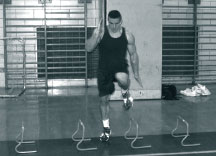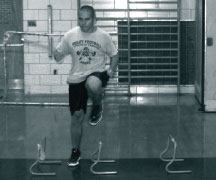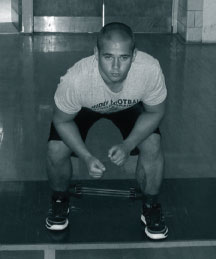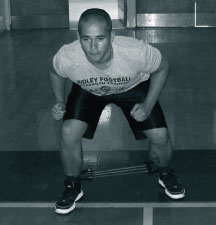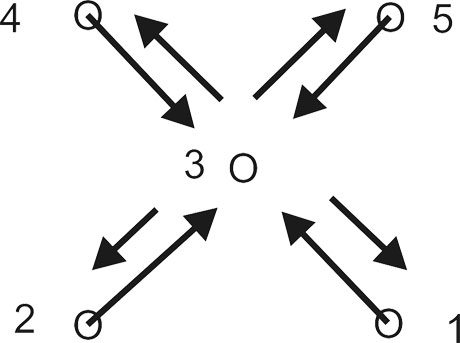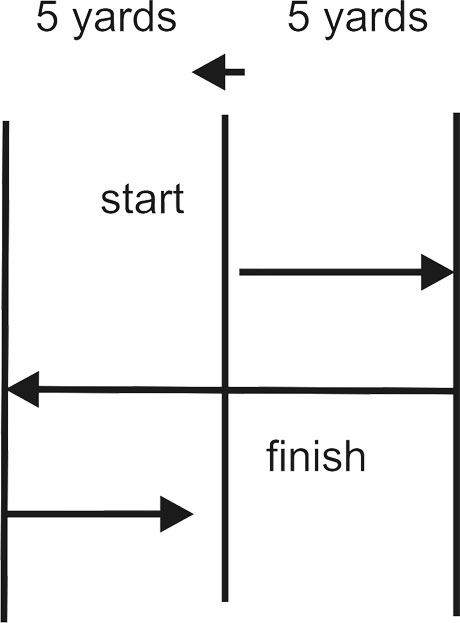AMERICAN FOOTBALL MONTHLY THE #1 RESOURCE FOR FOOTBALL COACHES
Article CategoriesAFM Magazine
|
Offensive Linemen: Developing Fast Feetby: Brian BowdenFootball Strength & Conditioning Coach & Asst. Coach, Ridley High School, Folsom, PA © More from this issue As an offensive line coach, you’ve probably learned by now that a football team has two types of players: skill and linemen. Players that are athletic and agile become backs and receivers while those that are slower, clumsier, and less athletic, inevitably, become linemen. Whereas I understand that backs and receivers need to have blazing speed and the ability to cut on a dime, as a line coach, I know that in order for linemen to be effective, they must have many of the same qualities, although not necessarily to the same degree. How else can we expect them to explode off the ball, pull into and outside the line, and block linebackers and defensive backs downfield? Therein lies the dilemma: how to help a non-athletic player develop the attributes we desire? In my opinion, there are three keys that must be established in order to be successful: COMMITMENT, APPROPRIATE TRAINING, and REFINED TECHNIQUE. COMMITMENT In order to achieve true athletic gains, there must be a commitment made by players and coaches alike. Furthermore, this commitment cannot begin at the start of summer camp. At that point, it is simply too late. It must be established early in off-season preparation. Players commit by sacrificing time and effort in order to better themselves for the sake of the team. Lackadaisical and half-hearted efforts are a waste of time and energy and cannot by tolerated. In addition, players must allow themselves to be coached and must trust in what their coaches are doing. In other words, they must “buy in” to the training program and believe that it will help in the long run. Coaches commit to this goal, by adjusting off-season schedules to include appropriate agility training in addition to whatever rigorous weight training sessions and X’s and O’s training is being done. Additionally, coaches must ensure that they are utilizing the most efficient and effective training methods available. APPROPRIATE TRAINING Once time has been established, all drills used must focus on the desired goals. Contrary to popular belief, research has shown that straight sprints, 12-minute runs, and other types of distance running does not translate into better agility. Simply put, if agility is the goal, specific agility training must be done. LADDER DRILLS: Ladder drills are a good way to help players develop better coordination and teach them to step with either foot as the lead foot, depending on the body’s position. There are numerous books and videos available for coaches to use as a resource to better develop their own well-rounded ladder circuit. HURDLES: Six inch or twelve inch hurdles can serve as an extension of ladder drills by not only developing foot coordination, but by increasing the difficulty of the drill by forcing players to learn to pick up their feet and get them back down on the ground as quickly as they can to maintain their balance.
Many of the same basic movements used with a ladder can be adapted to create a great hurdle workout. CONES: No training equipment would be complete without a good set of cones. The key, however, is not just having them, but using them appropriately. Their importance is two-fold. Everyone knows that they can be used in a similar fashion to ladders and hurdles when set in a variety of patterns or positions for players to run over, jump over, or zigzag around. The trick is learning to use them as guides to help players learn and refine many of the most basic blocks used by linemen (inside pulls, outside pulls, traps) to be effective. RESISTANCE BANDS: When teaching linemen blocking skills and developing good first steps, resistance bands are priceless. They are a great way to increase foot speed or overall explosion out of their stance by adding resistance to each step.
A variety of bands are available with resistances as low as a few pounds going up to resistances of a couple hundred pounds. Ultimately, your choice of bands will depend on the overall ability of the athlete and the desired goal. PLYOMETRIC TRAINING: Plyometric training, with or without jump boxes, can provide players an intense workout that forces players to move their feet. There are a variety of exercises and workouts available to help develop explosive power or quickness and agility, whichever is the desired outcome. The key is choosing the right workout. Plyometric training, however, should not be taken lightly. Because of the many safety issues revolving around intense plyometric training, and the increased risk of injury due to improper execution and improper safety protocols, coaches should not undertake this training unless they truly understand how to effectively apply the training principles. If utilized improperly, this type of training can actually do more harm than good. TECHNIQUE The final piece of the agility puzzle deals with technique development and refinement. Just because schedules are beautifully laid out and drills are truly innovative, if players are not taught how to properly execute key movements, all efforts may be for naught. One cannot assume that all “athletes” have been taught how to properly move, run, jump, or cut. Players need to be shown how to properly plant, push off, efficiently change direction, and effectively maneuver their body in space. This aspect of agility training must be meticulously developed and practiced until perfection is reached. In addition, blocking steps, such as pulling, trapping, and down blocking, must be repeated over and over until they become second nature. In game situations, linemen do not have time to think about their steps. All movements must be automatic, and the only way to achieve this is repetition. In addition, during any drill work, whether blocking or training based, speeds need to be manipulated to allow players to learn and then progress. In other words, start them slow and let them increase their speed as their ability increases. For years we’ve been told, “PRACTICE MAKES PERFECT”. That adage is a lie. A more appropriate adage is “PERFECT PRACTICE MAKES PERFECT”. This is the attitude coaches must take. To truly be effective, perfection must be sought; perfection in what is done and how to do it. These three keys to developing “FAST FEET” are a step in the right direction - a quick step in the right direction. Point of View: Ken Wilmesherr O Line Coach, Grossmont College I concur with Coach Bowden, offensive linemen need to be fundamentally tough and fundamentally sound in the run and pass game. Thus, to be an effective and fundamentally sound lineman requires patience, fortitude, and many hours of hard work in the off-season as well as in-season. It is imperative linemen understand that run and pass blocking is an unnatural task; however, through hours of hard work it can be developed to a greater degree than any other phase of the game. It is what we call skill acquisition; acquiring the necessary skills to be a successful lineman. The drills you choose should be functional and chosen for their benefits. Also, explain the concepts being taught so your players have a better understanding the importance of each drill you are teaching. It is important you demand perfection from your linemen as well as teach them to finish. In my opinion “perfect reps produce production.” Football games are won and lost in the off-season; therefore, off-season training is vital. One point I emphasize to my linemen is “the offensive line is an athletic position so play athletically.” Linemen are constantly redirecting their feet during each play. Therefore, one important aspect of line play is being able to redirect the feet, which starts with off-season training. Like coach Bowden, I also use ladders and resistance bands in the off-season to train my linemen, which we have had great success with. There are several other agility drills I teach to improve offensive linemen’s foot speed, foot quickness, and directional movement. Here are some Agility Drills to Improve Offensive Linemen’s Speed, Quickness, and Directional Movement. 1. Dot Drill: the dot drill will improve an offensive lineman’s agility and foot quickness. Paint 5 dots on the ground approximately 2 feet apart in the shape of a square, with one dot in the middle of the square. The lineman will place one foot on each dot.
Sequence: Place left foot on dot 1 place right foot on dot 2. Hop to dot 3 and then dots 4 and 5. Then hop backwards to dot 3 and then back to dots 2 and 1. Start on the right foot hop on dots 1, 3, 5 4, 3, 2, then when completed with right foot repeat the sequence with the left foot. These are just suggestions. 2. Jump Rope: jumping rope is the best way to develop quick feet for an offensive lineman. It is important to find a rope that will fit each individual lineman due to varies heights. Never have them jump flat-footed. Have them stay on the toes, which allows for more spring and control. 1. Both feet. 2. Left foot (10 right foot, 10 left foot, and repeat) 3. Right foot 4. Running in Place (forwards, backwards, side to side) Have your offensive linemen start slow with 25 jumps and increase to 50, 75, and then 100 jumps. 3. Four Corners: place 4 cones 10 yards in width and 10 yards in length; should make a square. Have the linemen start from the right corner (cone 1) in a proper 3-point stance. On a count (always give a snap count) each linemen will sprint from the first cone to the second cone make ½ a turn and carioca from the second cone to the third cone (make sure each lineman stays low and is quickly taking many steps while rotating the hips). The lineman then will make ½ a turn and back peddle from the third cone to the forth cone. The lineman will make ½ a turn and lateral shuffle maintaining a wide base shoulder width from the fourth to the first cone (do not have the lineman tap his heels; equal and opposite steps on the footwork) to the last cone. The lineman will make ½ turn and repeat the sequence 4 times.
4. Low bags or Agility bags: the objective of low bags or agility bags is to improve the foot quickness of offensive linemen and to teach them to keep their pad level down when changing directions. Lay six low bags approximately 2 feet apart on the ground. Have the offensive linemen line up in a straight line starting in front of the bags in a 3-point stance. Always give a snap count. On the snap count the offensive linemen will go over the bags. There are various drills you can do to improve offensive linemen’s foot quickness using low bags or agility bags. Foot Drills for Agility Bags: 1. Sprint over the bags: each lineman will run straight over the bags putting one foot in each hole pumping their arms. 2. Lateral steps: each lineman will turn sideways 45 degrees with the point of the inside shoulder facing the bags. Have them run laterally over the bags with out crossing the feet over. Have them pump their arms pushing off the outside foot and kicking the inside foot over each bag. 3. Twist: each lineman will turn 45 degrees with the point of the inside shoulder facing the bags. Have them run laterally over the first two bags. Then they will turn 180 degrees between the second and the third bag and run laterally. Then have them turn back 180 degrees between the fourth and fifth bag and they will run laterally completing the drill. When they turn it is one continuous motion do not have them stop their feet when making the turns. They are also pumping the arms. 4. Side to side: each line will face the bags taking wide and quick lateral steps weaving in an out of the bags. The feet should not cross over when changing directions. 5. Hops: each line will face the bags and hop over each bag keeping the feet together. 6. Two feet: each lineman will face the bags and pound two feet in each hole. Every drill you teach it is important to have each linemen finish the drill with a 5-yard burst. Finish the drill by having each lineman with his outside foot over the last bag driving up field for 5 yards. Allow space between each lineman by letting offensive linemen pass the fourth bag before the next o-linemen starts.
5. 20 Yard Shuttle Run: have the offensive lineman straddle the middle line in a 3-point stance (right handed or left handed stance). On a snap count have they will sprint to the first line they will touch the line with their hand and push off. They will now sprint pass the middle line to the far line and touch the line with their hand and push off and sprint through the middle line. Have them finish the drill do not let the let up before the last line. They must run through the last line of the drill. FINISH THE DRILL!
|
|
| HOME |
MAGAZINE |
SUBSCRIBE | ONLINE COLUMNISTS | COACHING VIDEOS |
Copyright 2024, AmericanFootballMonthly.com
All Rights Reserved



